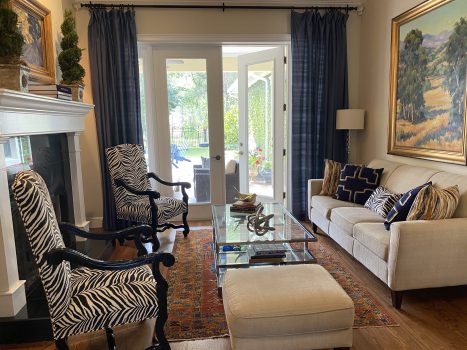
The move was risky. And I don’t regret it one bit.
I’ve always thought animal prints were for other people. That was then. I now have two zebra-striped chairs in my living room. With the blessing of a designer I trust, I tapped the animal within. Now I wonder what took me so long.
A few months ago, I realized my adjoining dining and living rooms looked tired. I wanted to update them, make them come alive, but I couldn’t afford to start over.
So, I called Los Angeles designer Christopher Grubb, whom I’ve known for years, and asked for a consult. I would do all the legwork, if he could just tell me what to keep, get rid of or revamp. We agreed I would keep the traditional dining table, but replace the stodgy tapestry dining side chairs with more modern ones. And keep the two dining room armchairs but reupholster them in a more contemporary fabric and move them into the living room.

I gathered nine fabric swatches to test drive and sent photos to Grubb. Then, before he could answer, I narrowed the selection and sent him a picture of the finalists, eliminating a bold zebra print I grabbed on a whim but ruled out. (It’s for other people.)
“What happened to the zebra?” Grubb asked.
“Oh, it seemed a little, well, wild.”
“It would look fantastic on those chairs,” he said. “And paint the wood glossy lacquer black.”
Designers take risks where the rest of us fear to tread. My little heart turned a somersault.
Next day, the tired tapestry armchairs, seven yards of zebra fabric and I were exuberantly off to the upholsterer, who took one look at the project, raised his eyebrows and said, “That will be fun.”
When the chairs came back, I sent Grubb a photo.
“Dang!” he said. “You turned them into not just useful pieces of furniture, but pieces of art.”
Many homeowners have furniture pieces that would look great flipped, but they just don’t see it. “They have heavy Mediterranean furniture they are trying to bust out of to make their homes more contemporary,” he said. “Then we give it a twist. Maybe we paint a humdrum brown end table robin’s egg blue and turn it into a fun and functional accessory.”
Worried it will “ruin” the piece? “You don’t like it anymore as it is, so what’s to lose?” he said.
“I’m a big fan of doing what you did,” said Dean Stills, co-owner of Stills Upholstery in Longwood, Fla. “I love to see people repurpose old furniture to make it fit their homes today by recovering it with more modern fabric and changing the finish. It’s so much better than taking it to the curb.”
Grubb encourages DIY decorators to work with designers the way I did. “Do the legwork, then hire a designer to consult for an hour or two,” he said. “People don’t take risks, so we walk through room after room of beige and grey.”
None of us wants to be that person.
If you’d like to add some pizzaz to your home, here are some moves Grubb and Stills suggest you consider.
Use the power of paint. A glossy fun color on brown wood furniture is an inexpensive way to modernize it and turn it into an art piece. (It’s also easier than refinishing.) Consider painting a chest a glossy lime or a mirror frame bright orange. When Stills painted my wood chairs glossy black, he used Crystal Conversion Varnish, because it creates a tough, hard finish that holds up.
Change the hardware. Switching out distressed iron knobs or ornate vintage pulls for sleek ones in brushed gold or polished chrome can instantly and inexpensively enliven old furniture.
Refresh fabrics. Before retiring a piece of upholstered furniture, think about recovering it. Older furniture, Stills said, is typically much better made than newer furniture sold today. Upholsterers can also replace and repair worn inner springs and foam.
Add a wow fixture. Chandeliers are a great place to take an expressive risk, Grubb said. “These standalone accessories don’t have to go with anything. They could be covered in feathers and look great.”
Incorporate some Lucite. Because it leans contemporary, just one Lucite piece, such as a chair, end table or bar cart, can bridge old and new looks, Grubb said.
Mix in some metal. Shiny metallic finishes also feel contemporary. Adding chrome table lamps, bookends or side tables can modernize an otherwise traditional room.
Reframe the art. Traditional art doesn’t need a traditional frame. Put an old painting in a contemporary frame or eliminate the frame altogether.
Marni Jameson is the author of seven books, including the new “Rightsize Today to Create Your Best Life Tomorrow.” Reach her at [email protected].
Join us for a free, virtual event series — “Rightsize Your Life and Live Well Now” — hosted by author, speaker and award winning nationally syndicated home-and-lifestyle columnist Marni Jameson on April 25 and May 23. Register at https://extras.mercurynews.com/events/.
